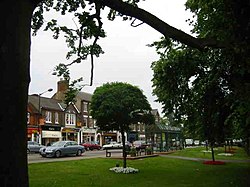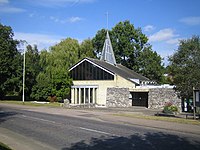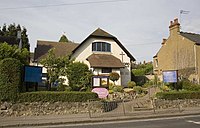Harpenden
| Harpenden | |
| Hertfordshire | |
|---|---|
 Harpenden | |
| Location | |
| Grid reference: | TL135145 |
| Location: | 51°49’3"N, 0°21’9"W |
| Data | |
| Population: | 29,881 |
| Post town: | Harpenden |
| Postcode: | AL5 |
| Dialling code: | 01582 |
| Local Government | |
| Council: | St Albans |
| Parliamentary constituency: |
Hitchin and Harpenden |
Harpenden is a town in Hertfordshire with a population of some 30,000.
Harpenden serves as a commuter town for London, by virtue of it fast and frequent rail link to the City: some trains stop at 'all stations' on the route, others stop at St Albans before continuing non-stop to London St Pancras International, a 25-minute journey. Trains also run north to Luton and on to Bedford.
In common with many well-to-do towns in Hertfordshire, Harpenden is an area of high property prices, assisted by the "top-heavy" nature of the town's property market which has a disproportionately high level of detached houses and far fewer terraced houses.
The River Lea flows through the Batford neighbourhood. The Nicky Line railway used to link Harpenden, Redbourn and Hemel Hempstead, long since lclosed, but its trackbed has been converted into a path forming part of the National Cycle Network. The M1 motorway runs nearby.
Contents
History
There are Roman remains in land around Harpenden, for instance in the park at Rothamsted. Harpenden village grew out of Westminster Abbey's gradual clearing of woodland for farming and settlement within its Wheathampstead manor, granted by Edward the Confessor in 1060. A first reference to a parish church is in 1221 (where it is referred to as Harpendene) so it is inferred that the village grew up around then. The Church of St Nicholas is the oldest church in the town, originally built as a chapel of ease in 1217.
Just beyond the southern edge of the town lies Nomansland Common (sometimes simply called "No Man's Land") upon which part of the Second Battle of St Albans was fought during the Wars of the Roses. Nomansland Common also saw the first annually contested steeplechase in England, in 1830 when it was organised by Thomas Coleman, and the last fight of nineteenth century bare-knuckle fighter, Simon Byrne. It was also the haunt of the highwaywoman known as Lady Katherine Ferrers, better known as the "Wicked Lady".
Between 1848 and 1914 the common was a regular venue for horse racing. In his History of Hertfordshire in 1879, John Edwins Cussans commented "Notwithstanding that these meetings are under the most unexceptional patronage as regards the Stewards, yet for two days in the year all the London pickpockets, sharpers and blackguards who happen to be out of gaol are permitted to make Harpenden their own and to make travelling in a first-class carriage on the Midland Railway a danger to men and an impossibility to ladies." Golf has been played on the Common since 1894 and it was at that time Harpenden Golf Club was set up by a group of Harpenden people with the help and a financial contribution of 5 pounds from Sir John Bennet Lawes of Rothamsted. The club moved to a new course at Hammonds End in 1931, at which time Harpenden Common Golf Club was formed by those who wanted to remain at the Common. In 1932 Bamville Cricket club was formed and shares part of the Common with the golfers - a truly unique situation within the worlds of golf and cricket.
A widespread but now little-known industry of Harpenden was straw-weaving, a trade mainly carried out by women in the nineteenth century. A good straw weaver could earn as much as a field labourer. The straw plaits were taken to the specialist markets in St Albans or Luton and bought by dealers to be converted into straw items such as boaters and other hats or bonnets.
The arrival of the railway system from 1860 and the sale of farms for residential development after 1880 radically changed Harpenden's surroundings. It grew from a basically agricultural village into a town.
During the Second World War, Harpenden was used to evacuate children from heavily-bombed London. However, Harpenden was not totally confident in its safety, as evidenced by the now decaying Bowers Parade air raid shelters, soon to be secured for the future. It has been suggested both that it be used for educational and emergency training purposes.[1]
The Harpenden and District Local History Society has a collection of local material and archives which can be consulted, and holds regular meetings on topics of historical interest.
Rothamsted
Harpenden's most prestigious contribution to history is Rothamsted Manor and Rothamsted Research (formerly Rothamsted Experimental Station and later the Institute of Arable Crops Research), a leading centre for agricultural research. In front of its main building, which faces the common, is a stone, erected in 1893, commemorating 50 years of experiments by Sir John Bennet Lawes and Joseph Henry Gilbert.
Lawes inherited the family estate at Rothamsted in 1834. Acknowledged as "the father of agricultural science", his early field experiments on Hertfordshire farms led him to patent a phosphate fertiliser, the sales of which enriched him immensely. With the proceeds, he established the experimental station, building laboratories in the 1850s. The station continued the development of the artificial fertilisers on which most modern farmers now depend. Some of the long-term 'classical field experiments' begun by Lawes and Gilbert remain in place to this day (such as Broadbalk) representing a unique resource for agricultural and environmental research.
Churches
Churches in Harpenden include:
- Church of England:
- All Saints
- St John ("the Church on the Common")
- St Mary
- St Nicholas
- Independent evangelical:
- Bethany Community Church (Newfrontiers)
- Christchurch
- Crabtree Church
- Harpenden International Church
- Network Church
- Methodist:
- High Street Methodist Church
- Batford Methodist Church
- Southdown Methodist Church
- Religious Society of Friends (Quakers)
- United Reformed Church: Harpenden United Reformed Church
- Salvation Army
- Missionary organisation: *Youth With a Mission
- Roman Catholic: Our Lady of Lourdes
Shopping
Harpenden has many shops commonly found in other English towns, with three central supermarkets, multiple flock shops, charity shops, banks, estate agents and chemists. A good proportion of these are run by independent retailers. The local council has resisted the opening of fast food chain outlets. Cafés are also common in Harpenden, but with only one commercial chain; the rest are owned independently. There are multiple restaurants, mainly of Italian origin, and many pubs; both in central Harpenden and in its suburbs.
Parks and commons
Harpenden has abundant parks and commons. The central area of Harpenden, known locally as "the village" is characterised by Church Green, Leyton Green and the High Street Greens, which give the town its provincial feel.
Just to the south of the town centre is Harpenden Common, stretching from the shops in the town centre for more than a mile to the south, encompassing a total of 238 acres. Today Harpenden Common hosts two cricket clubs, a football club, bridle ways for horse riding, ramblers paths,and Harpenden Common Golf Club, all contained in an area of natural beauty. Harpenden Town Council is keen to help retain and maintain the environment and oversees habitat issues including bird and bat watching, the maintenance/regeneration of gorse, fungi and all the original wildlife(fauna and flora) for the benefit of the people of Harpenden.
Since 1894 Harpenden Common Golf Club has traditionally maintained a large part of the Common and today works closely with Harpenden Town Council and Countryside management. This partnership has enabled the people of Harpenden to take full advantage of the Common for all kinds of leisure activities, and the relationship of the golfers and others users has been excellent for many years.
In addition the town has large green public spaces available in Rothamsted Park, Batford Park, Kinsbourne Green, Lydekker Park and the Nicky Line which bisects the town.
Just to the south of Harpenden is the large expanse of Nomansland Common.
Miscellany
- Rothamsted Research, the largest agricultural research centre in the United Kingdom, and perhaps the oldest in the world, is in Harpenden.
- Youth With A Mission an international Christian missionary organization, has their International Press Office and Head Office for the United Kingdom in Harpenden, on the site of the old National Children's Home.
- A annual classic car show, "Classics on the Common",[2] is held on the last Wednesday in July attracting over 10,000 visitors and 1,300 cars. One of the biggest events of its type in Europe, it is a free event with any monies collected going to charity.
- In the Monty Python's Flying Circus episode "Déjà vu", Michael Palin hijacks a plane and wants it to fly to Luton, then he changes his mind and wants them to take him to Harpenden.
Picture gallery
References
- ↑ [1] Harpenden Town Council meeting re: Air Raid Shelter
- ↑ Daily Telegraph report: Classic cars on the Common.html
Outside links
| ("Wikimedia Commons" has material about Harpenden) |






